The OnePlus 2 Review
by Brandon Chester on December 14, 2015 8:00 AM EST- Posted in
- Smartphones
- Mobile
- OnePlus
- OnePlus 2
Display
At this point, it's hard to excuse shipping a smartphone without a great display. Not just great in terms of resolution, contrast, and brightness, but also great in terms of color accuracy. We've seen even inexpensive smartphones like the Moto G and the Lumia 640 achieve levels of color accuracy that weren't achieved even by many flagship smartphones only a few years ago. As for OnePlus, the OnePlus One was notable for bringing a very accurate and high resolution display to a low price point, and at the time it was one of the best displays you could get on a smartphone. With that being achieved by their very first smartphone, OnePlus has some big shoes to fill with its follow up.
To analyze the quality of a smartphone's display we run it through our custom display workflow which measures accuracy relative to the sRGB color space. Measurements are performed with an i1Pro 2 spectrophotometer, with the exception of contrast measurements which are done with an i1Display Pro colorimeter. Data is collected and organized using SpectraCal's CalMAN 5 software.
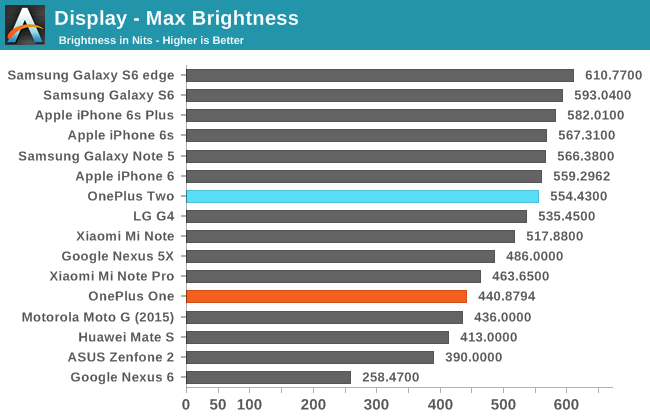
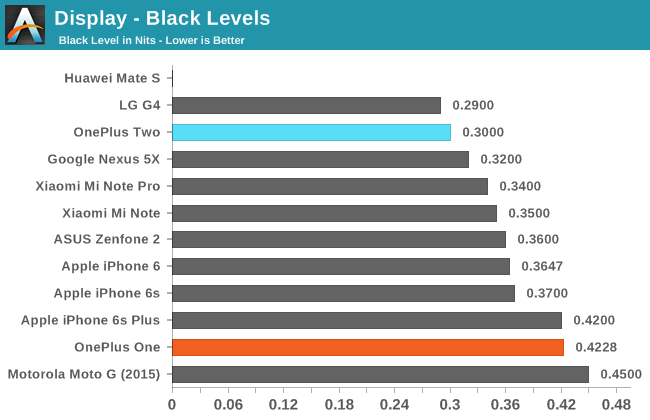
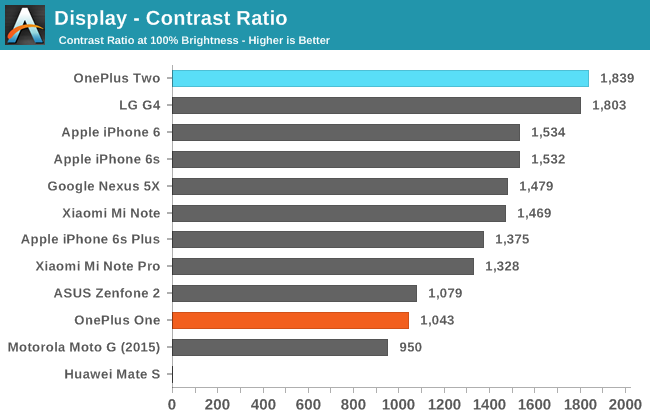
Out of the box, things look promising for the OnePlus 2. The display can get quite bright, and despite that it can also get quite dark, which leads to it achieving the best contrast ratio on record for an LCD device.
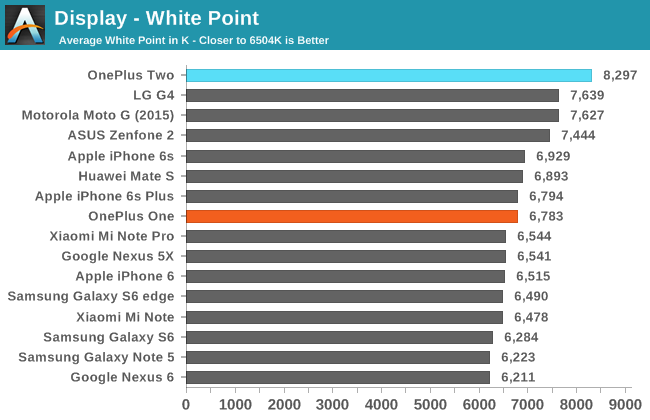
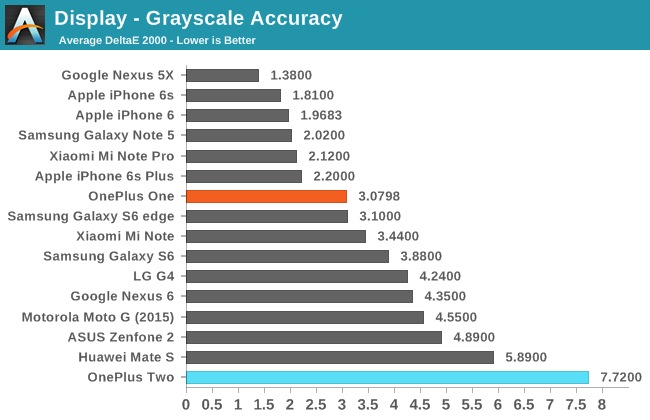
Unfortunately, there's not much good news beyond high brightness and deep blacks. Greyscale accuracy on the OnePlus 2 is extremely poor. Right out of the gate, there's a large imbalance between the red and blue components that make up the shades of grey, and that gap grows increasingly large as you move toward white. The gamma is also quite a disaster, with a high degree of irregularity. Honestly I don't really know what to say, as this result is quite shocking when one looks back at how accurate the OnePlus One was. The OnePlus 2 is simply too blue, and even without the blue shift the highly irregular gamma will cause issues with both greyscale and color mixture rendition.
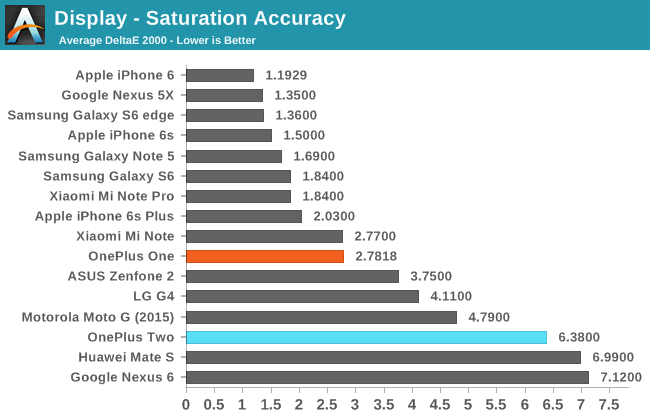
Moving on to the saturation sweep test, the OnePlus 2 again performs poorly. Every primary and secondary color with the exception of blue has a high degree of error, particularly red, magenta, and cyan. While in this test the phone narrowly avoids being the worst result on the chart, it's not very far off, and can hardly be called accurate. There's clear saturation compression occurring, with OnePlus managing to be accurate for more of the 100% saturation values, but being undersaturated for most values below that.

With poor greyscale accuracy, irregular gamma, and inaccurate rendition of primary and secondary colors, there's no hope for accurate color mixtures on the OnePlus 2's display. There's really not much more to be said. We're not talking about the kind of inaccuracy that you'd get from an oversaturated panel, but instead just general inaccuracy where no color is quite how it should be. It seems like OnePlus just focused on making sure the panel matched the sRGB gamut and put no effort into any further calibration.
The display quality of the OnePlus 2 is not impressive at all. For a $400 phone this is simply unacceptable, and it's such an enormous regression from the OnePlus One. What's even more problematic is how OnePlus keeps tweaking the display settings with their updates, and you never know whether it's going to change for the better or for the worse. I've seen the gamma curve change significantly, but the overall accuracy didn't improve for the better because some aspects improved and others got worse. In any case, I don't know what happened when OnePlus was deciding upon the display attributes they would be targeting, but as far as being accurate to the Rec. 709 standard goes the OnePlus 2 is actually one of the worst devices on record, and I'm at a loss as to how to explain why they allowed it to fall so far behind the original.




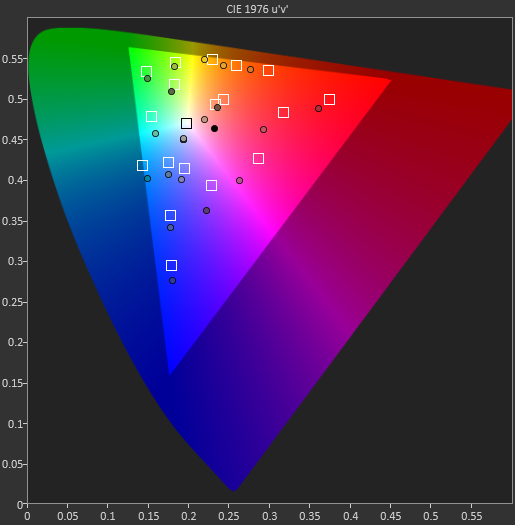








132 Comments
View All Comments
LiverpoolFC5903 - Tuesday, December 15, 2015 - link
Sorry for sounding thick! So basically even though ALL the cores are operating synchronously, indvidual cores in a cluster can be into different power states and/or shut off altogether?How does this compare with something like a Snapdragon 801 where all 4 cores run at different frequencies depending on the workload?
phoenix_rizzen - Tuesday, December 15, 2015 - link
The cores in the S810 work the same way as in the S801.There's 3 ways that ARM's big.LITTLE setup works:
1. Cluster migration: either the A57 cluster is active, or the A53 cluster is active. The OS only ever sees 1 cluster of cores (so an S810 would appear as a 4-core SoC). This is done in hardware on the SoC itself.
2. Core migration: each A57 core is paired with an A53 core. Either the A57 or the A53 is active in each pair, never both at the same time. But an A57 from pair 1 can be active while an A53 from pair 2 is active, while the other two pairs are offline, for example. The OS only ever sees 1 cluster's worth of CPUs (so the S810 would appear as a quad-core). I believe this is done in hardware on the SoC itself.
3. Forget the name of this one, but all cores in all clusters are available for scheduling, and it's up to the OS to manage everything. 1 core can be online, 2 cores can be online, all the way up to all 8 cores can be online. And the kernel scheduler determines whether a process runs on an A53 core or an A57 core.
The first big.LITTLE SoCs from Samsung (the Exynos 54xx-something) used method 1. The latest big.LITTLE SoCs from everyone (Exynos 7xxx, Snapdragon 810/808, MediaTek Helios, etc) uses method 3.
LiverpoolFC5903 - Wednesday, December 16, 2015 - link
Thanks mate, but as Andrei pointed out, my question was a different one. But useful information all the same.Andrei Frumusanu - Tuesday, December 15, 2015 - link
Please ignore phoenix's comment, he seems to have misunderstood the question at hand.The Snapdragon 801 behaves as you say, they each have individual frequencies, meaning they're all on their own clock domain. Also each core has their own power domain, meaning each core can be individually turned off.
The difference again is that ARM CPUs such as the A57 in the S810 have all the same clock domain. However even if they all have the same clock they can still be individually powered off as the power domains are individual as well.
As to how it compares, it has both benefits and disadvantages. But there seems to be no clear winner.
LiverpoolFC5903 - Wednesday, December 16, 2015 - link
Thank you Andrei, its pretty clear to me now! Synchronous cores (A57, standard ARM cores) have the same clock domain which means cluster frequency remains the same. However, individual cores within each cluster can be powered off based on need and workloads.And Krait based quadcores have different clock domains for each core as well as different power domains.
Understood.
WoodyPWX - Tuesday, December 15, 2015 - link
Nice and honest review as always, thank you! A Lumia 950xl review would be awesome.victorson - Tuesday, December 15, 2015 - link
I love Anand and the insight in the reviews, but sometimes you guys throw something that even the more experienced reader will find hard to understand. "As always, all devices are calibrated to 200nits except when their brightness curves necessitate testing above that value." Could you kindly elaborate on what is that supposed to mean to those of us who are interested in display quality, but don't have a PhD on the matter? :)Ryan Smith - Tuesday, December 15, 2015 - link
As close to 200nits as we can get. If we can't hit 200 exactly, then it's the first value over that which we can hit.kasakka - Tuesday, December 15, 2015 - link
The sandstone black back cover is one of the best things about Oneplus phones. It really helps keeping a big phone like that firmly in your hands. By comparison the Oneplus X or iPhone 6S really needs a cover because they are very slippery.Where Oneplus went wrong with the Two was the Snapdragon 810 and that it's not that much of an upgrade from the One. As a One owner, the only things I'd like from it are LTE band 20, better speaker and vibration motor and the fingerprint reader which is positioned very poorly. On phones this size they should be in the back like on the Nexus phones because reaching down to that bottom area when using with one hand is quite annoying. I use the onscreen buttons on my One because of the same reason.
I really hope they manage a better design with the inevitable Oneplus Three. I like that they haven't jumped on the 1440p bandwagon because that doesn't really give any benefit in phones at this screen size. Just more pixels to push.
lid - Tuesday, December 15, 2015 - link
Thank you for providing LTE band information! It has always been a deciding factor for me, since I travel constantly. This phone doesn't seem great for anyone who frequently visits the EU from the US (since the US version is missing LTE band 3), or vice versa (since the EU version is missing LTE bands 2/4).